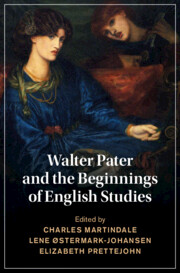Book contents
- Walter Pater and the Beginnings of English Studies
- Cambridge Studies in Nineteenth-Century Literature and Culture
- Walter Pater and the Beginnings of English Studies
- Copyright page
- Contents
- Figures
- Contributors
- Preface
- Abbreviations
- Introduction: Pater and English Literature
- Part I General
- Introduction to Part I
- Chapter 1 ‘Of the true family of Montaigne’: Appreciations and the Essay Tradition in English Literature
- Chapter 2 Unravelling Pater’s English Poet: The Imaginary Portrait as Criticism
- Chapter 3 Pater’s Montaigne and the Selfish Reader
- Chapter 4 Studies in European Literature: Pater’s Cosmopolitan Criticism
- Chapter 5 The ‘Postscript’
- Chapter 6 Form, Matter, and Metaphysics in Walter Pater’s Essay on ‘Style’
- Chapter 7 Walter Pater, Second-Hand Stylist
- Part II Individual Authors: Early Moderns, Romantics, Contemporaries
- Postscript
- Walter Pater and English Studies: A Select Bibliography
- Index
- Cambridge Studies in Nineteenth-Century Literature and Culture
Chapter 7 - Walter Pater, Second-Hand Stylist
from Part I - General
Published online by Cambridge University Press: 14 November 2023
- Walter Pater and the Beginnings of English Studies
- Cambridge Studies in Nineteenth-Century Literature and Culture
- Walter Pater and the Beginnings of English Studies
- Copyright page
- Contents
- Figures
- Contributors
- Preface
- Abbreviations
- Introduction: Pater and English Literature
- Part I General
- Introduction to Part I
- Chapter 1 ‘Of the true family of Montaigne’: Appreciations and the Essay Tradition in English Literature
- Chapter 2 Unravelling Pater’s English Poet: The Imaginary Portrait as Criticism
- Chapter 3 Pater’s Montaigne and the Selfish Reader
- Chapter 4 Studies in European Literature: Pater’s Cosmopolitan Criticism
- Chapter 5 The ‘Postscript’
- Chapter 6 Form, Matter, and Metaphysics in Walter Pater’s Essay on ‘Style’
- Chapter 7 Walter Pater, Second-Hand Stylist
- Part II Individual Authors: Early Moderns, Romantics, Contemporaries
- Postscript
- Walter Pater and English Studies: A Select Bibliography
- Index
- Cambridge Studies in Nineteenth-Century Literature and Culture
Summary
Oxford classicist, lover of Renaissance art, Pater might seem to belong in a different atmospheric universe from that which presided over the emergence of intertextual theory in the Paris of the 1960s. While his name is virtually synonymous with subjective aesthetic response, the notion of intertextuality, first named and honed at the hands of Julia Kristeva, Roland Barthes, and Michel Foucault, is, by contrast, tightly intertwined with the idea of authorial impersonality. Yet these realms and modes of thought are not as dichotomous as they may initially appear, however starkly distinct their critical languages. Over the decades since his death, Pater’s work has given rise to considerable comment regarding his use of source material. This chapter examines Pater’s practice of ‘second-hand’ writing in ‘Style’ – in particular his borrowings from Flaubert and Maupassant – in the light of intertextual theory in comparison with the extreme citational practices of Flaubert and Joyce. Highlighting significant similarities and differences between their treatment of sources, it brings into focus the specificity of Pater’s drive to style the second-hand.
Keywords
- Type
- Chapter
- Information
- Walter Pater and the Beginnings of English Studies , pp. 133 - 148Publisher: Cambridge University PressPrint publication year: 2023



